MaryAnn Bernal's Blog, page 90
July 6, 2016
5,000-Year-Old Mesopotamian Pay Stub Reveals Workers Were Paid with Beer
Ancient Origins
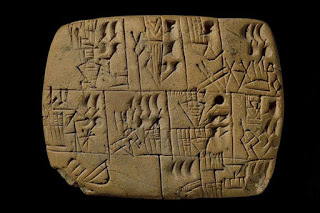
An ancient cuneiform tablet dating back to 3,000 BC, which was discovered in the Mesopotamian city of Uruk, in modern day Iraq, reveals that the workers of the ancient city were paid with beer rations.
Beer was then a thick, nutritious, carbohydrate-loaded brew that fueled the labor of Mesopotamian and also Egyptian workers as they did the hard work of constructing stone buildings, monuments, ziggurats and pyramids.
New Scientist reports that the Mesopotamian pay stub is one of the oldest known examples of writing. The article states:
Perhaps it’s no surprise that one of the earliest known examples of writing features two basic human concerns: alcohol and work. About 5000 years ago, the people living in the city of Uruk, in modern day Iraq, wrote in a picture language called cuneiform. On one tablet excavated from the area we can see a human head eating from a bowl, meaning “ration”, and a conical vessel, meaning “beer.” Scattered around are scratches recording the amount of beer for a particular worker. It’s the world’s oldest known payslip, that the concept of worker and employer was familiar five millennia ago.Uruk was not the only place in the ancient world where people were paid in beer. According to an article on Smithsonian.org quotes libation archaeologist Patrick McGovern as saying: “For the pyramids, each worker got a daily ration of four to five liters. It was a source of nutrition, refreshment and reward for all the hard work. It was beer for pay. You would have had a rebellion on your hands if they’d run out. The pyramids might not have been built if there hadn’t been enough beer.”
 The Uruk archaeological site in Mesopotamia; as in Egypt, the Mesopotamians built their monuments in stone and paid their workers in beer. (
Wikimedia photo
)Monument and pyramid workers also received bread as part of their wages. After all, man does not live by beer alone.
The Uruk archaeological site in Mesopotamia; as in Egypt, the Mesopotamians built their monuments in stone and paid their workers in beer. (
Wikimedia photo
)Monument and pyramid workers also received bread as part of their wages. After all, man does not live by beer alone.Ars Technica points out that Geoffrey Chaucer was paid about 252 gallons of wine per year by Richard II of England. The member of parliament, government official and author of The Canterbury Tales lived in the 14th century AD.
Even in modern times, one of the perks of working at certain establishments in some countries is drinking beer or other intoxicating beverages for free.
Regarding Mesopotamia, the epic of Gilgamesh has a passage on beer in which Enkidu becomes cultured by beer and bread:
Enkidu, a shaggy, unkempt, almost bestial primitive man, who ate grass and could milk wild animals, wanted to test his strength against Gilgamesh, the demigod-like sovereign. Taking no chances, Gilgamesh sent a (prostitute) to Enkidu to learn of his strengths and weaknesses. Enkidu enjoyed a week with her, during which she taught him of civilization. Enkidu knew not what bread was nor how one ate it. He had also not learned to drink beer. The (prostitute) opened her mouth and spoke to Enkidu: 'Eat the bread now, O Enkidu, as it belongs to life. Drink also beer, as it is the custom of the land.' Enkidu drank seven cups of beer and his heart soared. In this condition he washed himself and became a human being.Gilgamesh was written in the 3rd millennium BC, some time after this ancient pay stub was issued. The epic of Gilgamesh also takes place in the city of Uruk.
 Tablet 5 of the epic of Gilgamesh (
Wikimedia photo/
Osama Shukir Muhammed Amin FRCP(Glasg))The site BeerInTheWorld.com says historians have traced beer’s roots to ancient African, Egyptian and Sumerian tribes. Sumer was a part of ancient Mesopotamia. “The oldest proven records of brewing are about 6,000 years old and refer to the Sumerians,” the site says. “It is said that the Sumerians discovered the fermentation process by chance.”
Tablet 5 of the epic of Gilgamesh (
Wikimedia photo/
Osama Shukir Muhammed Amin FRCP(Glasg))The site BeerInTheWorld.com says historians have traced beer’s roots to ancient African, Egyptian and Sumerian tribes. Sumer was a part of ancient Mesopotamia. “The oldest proven records of brewing are about 6,000 years old and refer to the Sumerians,” the site says. “It is said that the Sumerians discovered the fermentation process by chance.”Featured image: This is the oldest known pay stub in the world, dating back 5,000 years to the city of Uruk in Mesopotamia. The wages were beer. (British Museum photo)
By Mark Miller
Published on July 06, 2016 03:00
July 5, 2016
Examination of 1,000-Year-Old Viking ‘Death House’ Reveals Elite Burial with Stunning Artifacts
Ancient Origins
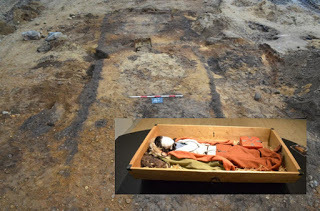
A team of researchers have examined a rare Viking tomb known as a ‘death house’, revealing an elite burial containing the remains of two noblemen and a woman, along with impressive artifacts including a large battle axe.
The initial discovery of the grave took place in south west Denmark in 2012, during construction work to create a new highway. The burial was identified as a rare Viking tomb known as a ‘d'ødehus’', meaning ''death house''. Since the beginning, it has been obvious that the tomb belonged to a highly distinguished person or people.
The tomb measures 4m by 13m and contained three burials dating back to 950 AD. Unfortunately, the soil conditions at the site affected the preservation of the human remains. However, an analysis of the burial finds allowed the researchers to confirm that it is a grave of two men and a woman. According to excavation leader Kirsten Nelleman Nielsen, who described the finding in an article called 'Dead and buried in the Viking Age' published by Saxo Institute at the University of Copenhagen, it seems that one man and a woman were buried together in the main part of the tomb, while another man was buried in the back. The third grave in the tomb had been added later.
 Sketch of the tomb layout. On the left, is a room with two graves belonging to a man and a woman. On the right, is an additional grave for a man that was added later. (Illustration: Museum Silkeborg)Science Nordic reports that the man in the main part of the tomb was buried with an impressive battle axe.
Sketch of the tomb layout. On the left, is a room with two graves belonging to a man and a woman. On the right, is an additional grave for a man that was added later. (Illustration: Museum Silkeborg)Science Nordic reports that the man in the main part of the tomb was buried with an impressive battle axe.
"It’s a very large axe and would have been a formidable weapon. People across Europe feared this type of axe, which at the time was known as the Dane Axe--something like the ‘machine gun’ of the Viking Age,” says Nielsen.
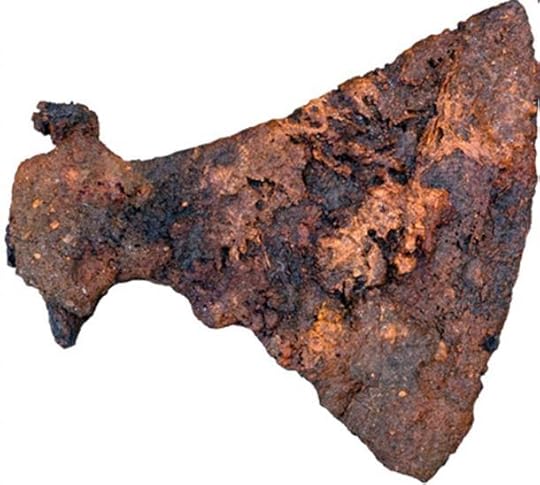 Archaeologists found a large axe buried in one of the men's graves (Photo: Museum Silkeborg)The woman was buried with two keys. One of them was a symbol of her status and power as a noble woman, while the second one fits a small square shrine that was also buried with her. Moreover, she was buried in a wagon, which was typically used by women of noble birth.
Archaeologists found a large axe buried in one of the men's graves (Photo: Museum Silkeborg)The woman was buried with two keys. One of them was a symbol of her status and power as a noble woman, while the second one fits a small square shrine that was also buried with her. Moreover, she was buried in a wagon, which was typically used by women of noble birth.
Other grave goods included a smaller battle axe in the second man’s grave, ceramics, and two silver coins that came from as far away as Afghanistan.
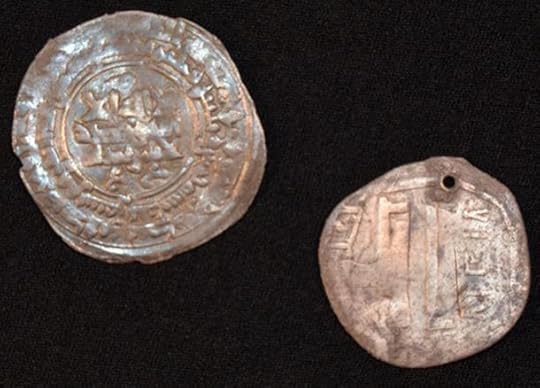 Two silver coins found at the site came from as far away as Afghanistan (Museum Sikeborg)The researchers suggest that the man and woman may have been local rulers, while the third man may have been a successor.
Two silver coins found at the site came from as far away as Afghanistan (Museum Sikeborg)The researchers suggest that the man and woman may have been local rulers, while the third man may have been a successor.
The most unique fact about the finding is that both the man and woman are buried in the same elaborate tomb, which suggests that they held equal positions in society. While it is not as common to find graves of such high status women, some female burials with rich grave goods have been found. As Natalia Klimczak from Ancient Origins wrote in April 19, 2016:
By Natalia Klimzcak

A team of researchers have examined a rare Viking tomb known as a ‘death house’, revealing an elite burial containing the remains of two noblemen and a woman, along with impressive artifacts including a large battle axe.
The initial discovery of the grave took place in south west Denmark in 2012, during construction work to create a new highway. The burial was identified as a rare Viking tomb known as a ‘d'ødehus’', meaning ''death house''. Since the beginning, it has been obvious that the tomb belonged to a highly distinguished person or people.
The tomb measures 4m by 13m and contained three burials dating back to 950 AD. Unfortunately, the soil conditions at the site affected the preservation of the human remains. However, an analysis of the burial finds allowed the researchers to confirm that it is a grave of two men and a woman. According to excavation leader Kirsten Nelleman Nielsen, who described the finding in an article called 'Dead and buried in the Viking Age' published by Saxo Institute at the University of Copenhagen, it seems that one man and a woman were buried together in the main part of the tomb, while another man was buried in the back. The third grave in the tomb had been added later.
 Sketch of the tomb layout. On the left, is a room with two graves belonging to a man and a woman. On the right, is an additional grave for a man that was added later. (Illustration: Museum Silkeborg)Science Nordic reports that the man in the main part of the tomb was buried with an impressive battle axe.
Sketch of the tomb layout. On the left, is a room with two graves belonging to a man and a woman. On the right, is an additional grave for a man that was added later. (Illustration: Museum Silkeborg)Science Nordic reports that the man in the main part of the tomb was buried with an impressive battle axe."It’s a very large axe and would have been a formidable weapon. People across Europe feared this type of axe, which at the time was known as the Dane Axe--something like the ‘machine gun’ of the Viking Age,” says Nielsen.
 Archaeologists found a large axe buried in one of the men's graves (Photo: Museum Silkeborg)The woman was buried with two keys. One of them was a symbol of her status and power as a noble woman, while the second one fits a small square shrine that was also buried with her. Moreover, she was buried in a wagon, which was typically used by women of noble birth.
Archaeologists found a large axe buried in one of the men's graves (Photo: Museum Silkeborg)The woman was buried with two keys. One of them was a symbol of her status and power as a noble woman, while the second one fits a small square shrine that was also buried with her. Moreover, she was buried in a wagon, which was typically used by women of noble birth.Other grave goods included a smaller battle axe in the second man’s grave, ceramics, and two silver coins that came from as far away as Afghanistan.
 Two silver coins found at the site came from as far away as Afghanistan (Museum Sikeborg)The researchers suggest that the man and woman may have been local rulers, while the third man may have been a successor.
Two silver coins found at the site came from as far away as Afghanistan (Museum Sikeborg)The researchers suggest that the man and woman may have been local rulers, while the third man may have been a successor.The most unique fact about the finding is that both the man and woman are buried in the same elaborate tomb, which suggests that they held equal positions in society. While it is not as common to find graves of such high status women, some female burials with rich grave goods have been found. As Natalia Klimczak from Ancient Origins wrote in April 19, 2016:
''The partial skeleton of a young woman was discovered in 1938 at Ketilsstaðir, in eastern Iceland. She lived in the 9th or 10th century AD and was found with typical copper-alloy Scandinavian oval brooches, one of which was in direct contact with her face, resulting in significant soft tissue and textile preservation. The skeleton was very poorly preserved and incomplete, but after many decades, a team led by Jakob and Joe Walser III of the University of Iceland in Reykjavik, decided to re-examine it…Top image: Main: Outline of the 1000-year-old tomb. Inset: reconstruction shows how the woman may have looked in Viking times (Photo: Museum Silkeborg)
According to Science News, she was buried with Viking-era artifacts and she could have been a child of the earliest settlers of Iceland. Moreover, she was buried in a blue apron. The apron's blue dye was plant-based, and cloth with exactly this color is characteristic of female Viking clothing.''
By Natalia Klimzcak
Published on July 05, 2016 03:00
July 4, 2016
Fourth of July - Happy Birthday USA
Published on July 04, 2016 02:00
Scribbler Tales Volumes One - Five - e-book edition 50% off on Smashwords - for a limited time only
SMASHWORDS SUMMER/WINTER SALE RUNS JULY 1 THOUGH JULY 31
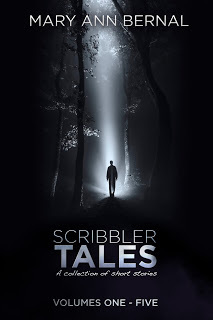 Scribbler Tales Volume One
Scribbler Tales Volume One
In Desperate Measures, Audrey learns of Paul’s duplicity when human cloning experiments go awry. Forbidden Lore beckons Arianna and Ethan into a haunted cemetery where they are confronted by a gathering of witches with evil intent . Adrian must challenge his father to marry Rina or suffer the fate of star-crossed lovers in Forever Lost. In The Hourglass, Flair makes a covenant with the Devil to keep Brice alive. Aaron reflects upon his childhood as a military brat in Sail with Me.
Scribbler Tales Volume Two
Madeline’s personal feelings clouds her judgment in Broken Promises where she must choose between love and obeying the law. When the guilty walk, a vigilante executes the criminals in Deception. Endgame finds a government researcher running for her life after discovering a horrific CIA secret in the isolated facility. A modern day Don Juan’s life is turned upside down in Malice when he is falsely accused of rape. In The Portrait, Holliday is obsessed with a formidable ancestor whose spirit wishes to possess her soul.
Scribbler Tales Volume Three
When a highly classified schematic of a prototype engine is stolen, the evidence points to an inside job in Hidden Lies. In Nightmare, Melanie’s childhood demons carryover into adulthood when she returns to her ancestral home. Detective Newport races against time to apprehend a killer targeting prosecuting attorneys in Payback. The Night Stalker is not a figment of Pamela’s imagination as she tries to convince the police that her life is in danger. While trying to identify a serial arsonist, a Fire Marshall suspects a highly decorated firefighter in Turning Point.
Scribbler Tales Volume Four
When the daughter of a wealthy entrepreneur is kidnapped, Agent Richards races against time to find her in Abducted. In Cunning, newlywed Charlotte von Lichtner is obsessed with Transylvanian folklore when she encounters her husband’s mysterious kinsman. Enamored finds Lady Margaret besotted with a younger man whose intentions are suspect in their unorthodox relationship. Will the murderer succeed as he flees the crime scene in Reckless? Doctor/patient confidentiality is sorely tested when Sarah reveals the truth about her lover’s death in Safeguard.
Scribbler Tales Volume Five
In her quest for immortality, Lilly considers a Satanic covenant before the portal closes on All Hallows’ Eve in Bloodlust. When Felicity meets exotic Seth on a flight to Luxor, her fairy tale vacation is threatened by tomb robbers in Illusion. Manhunt finds Tami and Mick suspecting the newest member of their team while planning one final heist at the Diamond Exchange. Dr. Brenda Lancaster must develop a cure for a mutated pathogen before mankind becomes extinct in Pandemic. Angela plots her husband’s death in Revenge, unaware it may cost her the freedom she seeks.
Smashwords Link
Use the code SSW50 at checkout for 50% off during Smashwords' site-wide promotion!
(Offer good through July 31, 2016)
 Scribbler Tales Volume One
Scribbler Tales Volume OneIn Desperate Measures, Audrey learns of Paul’s duplicity when human cloning experiments go awry. Forbidden Lore beckons Arianna and Ethan into a haunted cemetery where they are confronted by a gathering of witches with evil intent . Adrian must challenge his father to marry Rina or suffer the fate of star-crossed lovers in Forever Lost. In The Hourglass, Flair makes a covenant with the Devil to keep Brice alive. Aaron reflects upon his childhood as a military brat in Sail with Me.
Scribbler Tales Volume Two
Madeline’s personal feelings clouds her judgment in Broken Promises where she must choose between love and obeying the law. When the guilty walk, a vigilante executes the criminals in Deception. Endgame finds a government researcher running for her life after discovering a horrific CIA secret in the isolated facility. A modern day Don Juan’s life is turned upside down in Malice when he is falsely accused of rape. In The Portrait, Holliday is obsessed with a formidable ancestor whose spirit wishes to possess her soul.
Scribbler Tales Volume Three
When a highly classified schematic of a prototype engine is stolen, the evidence points to an inside job in Hidden Lies. In Nightmare, Melanie’s childhood demons carryover into adulthood when she returns to her ancestral home. Detective Newport races against time to apprehend a killer targeting prosecuting attorneys in Payback. The Night Stalker is not a figment of Pamela’s imagination as she tries to convince the police that her life is in danger. While trying to identify a serial arsonist, a Fire Marshall suspects a highly decorated firefighter in Turning Point.
Scribbler Tales Volume Four
When the daughter of a wealthy entrepreneur is kidnapped, Agent Richards races against time to find her in Abducted. In Cunning, newlywed Charlotte von Lichtner is obsessed with Transylvanian folklore when she encounters her husband’s mysterious kinsman. Enamored finds Lady Margaret besotted with a younger man whose intentions are suspect in their unorthodox relationship. Will the murderer succeed as he flees the crime scene in Reckless? Doctor/patient confidentiality is sorely tested when Sarah reveals the truth about her lover’s death in Safeguard.
Scribbler Tales Volume Five
In her quest for immortality, Lilly considers a Satanic covenant before the portal closes on All Hallows’ Eve in Bloodlust. When Felicity meets exotic Seth on a flight to Luxor, her fairy tale vacation is threatened by tomb robbers in Illusion. Manhunt finds Tami and Mick suspecting the newest member of their team while planning one final heist at the Diamond Exchange. Dr. Brenda Lancaster must develop a cure for a mutated pathogen before mankind becomes extinct in Pandemic. Angela plots her husband’s death in Revenge, unaware it may cost her the freedom she seeks.
Smashwords Link
Use the code SSW50 at checkout for 50% off during Smashwords' site-wide promotion!
(Offer good through July 31, 2016)
Published on July 04, 2016 01:30
July 3, 2016
The Briton and the Dane: The Complete Trilogy - e-book edition 50% off on Smashwords - for a limited time only
SMASHWORDS SUMMER/WINTER SALE RUNS JULY 1 THOUGH JULY 31, 2016
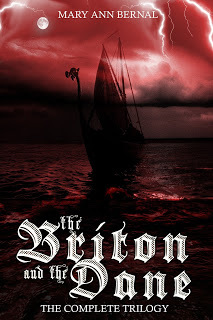
The Briton and the Dane: A wounded Danish Viking is secretly given succor by a young Anglo-Saxon woman who is intelligent, self-sufficient and not afraid to follow her convictions. Gwyneth and Erik fight to remain together in this story of love, betrayal, intrigue and warfare set in ninth century England.
The Briton and the Dane: Birthright: Rigr demands his Birthright, but King Guthrum refuses his claim; thus, the bastard son assembles his army while his father summons his forces. The bloodthirsty warriors confront each other on the windless plains of East Anglia, and the fate of England is in the hands of the gods of war.
The Briton and the Dane: Legacy Danish Prince Sven instigates a seaborne invasion, fueled partly by blind rage when he discovers that his brother, Prince Erik, has sworn fealty to the Anglo-Saxon king. Amidst the ferrous reverberation of a naval battle, one or all must die, and the fate of a nation hangs in the balance, one final time.
Smashwords Link
Use the code SSW50 at checkout for 50% off during Smashwords' site-wide promotion!
(Offer good through July 31, 2016)

The Briton and the Dane: A wounded Danish Viking is secretly given succor by a young Anglo-Saxon woman who is intelligent, self-sufficient and not afraid to follow her convictions. Gwyneth and Erik fight to remain together in this story of love, betrayal, intrigue and warfare set in ninth century England.
The Briton and the Dane: Birthright: Rigr demands his Birthright, but King Guthrum refuses his claim; thus, the bastard son assembles his army while his father summons his forces. The bloodthirsty warriors confront each other on the windless plains of East Anglia, and the fate of England is in the hands of the gods of war.
The Briton and the Dane: Legacy Danish Prince Sven instigates a seaborne invasion, fueled partly by blind rage when he discovers that his brother, Prince Erik, has sworn fealty to the Anglo-Saxon king. Amidst the ferrous reverberation of a naval battle, one or all must die, and the fate of a nation hangs in the balance, one final time.
Smashwords Link
Use the code SSW50 at checkout for 50% off during Smashwords' site-wide promotion!
(Offer good through July 31, 2016)
Published on July 03, 2016 11:37
Tudor women: what was life like?
History Extra
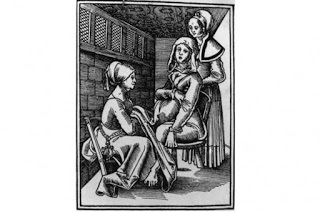
A midwife and friend attend to a woman giving birth at home, c1513. The original artwork is an illustration from Rosslin's 'Der Wanglien Frauer and Hebammen Kofegarter'. (Photo by Hulton Archive/Getty Images)
In her forthcoming book, historian Elizabeth Norton explores the seven ages of the Tudor woman, from childhood to old age, through the diverging examples of women such as Elizabeth Tudor, Henry VIII's sister who died in infancy; Cecily Burbage, Elizabeth's wet nurse; and Elizabeth Barton, a peasant girl who would be lauded as a prophetess. Their stories are interwoven with studies of topics ranging from Tudor toys to contraception to witchcraft.
Here, writing for History Extra, the author of The Lives Of Tudor Women reveals how women at all levels made their mark on society, commerce and in the home…
BirthConception and then birth were, of course, the first life stage for all Tudor women. They were also important events for adult women in the period, most of whom would have expected to become mothers. Pregnancy, however, was notoriously difficult to diagnose. Could a woman’s symptoms merely be “her natural sickness or store of water”, one contemporary medical text suggested? Alternatively, an increase in girth could be due to “some windy matter” and not an expected baby. Indeed, few physicians were prepared to confirm their diagnosis until the child actually began to stir in the womb. A mistake could be highly embarrassing for all concerned, and so for months women were left on tenterhooks.
Once pregnancy was established, however, a woman was advised to spend time in “good tempered air”. Even queens adapted their existing clothes, with extra panels added to their dresses. They could supplement this with more specific maternity wear, such as ‘self grow’ waistcoats, kirtles and gowns that could be let out as the wearer’s pregnancy advanced. More simply, a gown could first be unlaced, before more drastic changes were required.
Thoughts would then turn to the birth. For royalty, there was an elaborate ceremonial to follow, with the queen retiring to her chamber a month before the expected birth. Poorer women, too, made preparations, with birthing sheets sometimes passed down through families from mother to daughter.
Some women were taken entirely by surprise, however. Little Mary Cheese of Hounslow in Surrey was unfortunate enough to be born while her mother was out walking in town in March 1573. The birth was so sudden that Mary Cheese suffered a fatal head injury as she fell to the floor beneath her mother’s skirts.
Just over 80 years before, Queen Elizabeth of York gave birth to her fourth child – a daughter named Elizabeth – who was immediately handed to a wetnurse and a team of cradle rockers, who had been engaged in advance of the birth. Elizabeth was taken to the royal nursery where she, like all children, later spent her time at play. For wealthy children there were dolls, rattles, windmills and hobbyhorses, while the parents of poorer children fashioned more makeshift toys.
In spite of this fun, infancy was always a perilous time. Princess Elizabeth died in September 1495 at the age of three from unspecified causes. Many of her peers also failed to reach adulthood.
EducationAlthough the lawyer, scholar and chancellor Thomas More famously gave his daughters a fine education, most Tudor parents were less enlightened. The educationalist Richard Mulcaster, addressing the issue in the 1580s, was quick to assure his readers that he would speak of boys’ education first, since “naturally the male is more worthy”. Nonetheless, he did acknowledge that girls had some capacity to learn.
By the start of the 16th century, girls were commonly attending local schools along with their male peers. There was one such school in London between 1504 and 1515, which was run by an aged priest named William Barbour. Barbour took in 30 students of both sexes, teaching them both religious doctrine and “further learning”. Many other such schools are also known. Even the very poorest girls in Norwich in the 1560s went to school, although their evenings were spent spinning to help support their families. No girls were permitted to attend university, but a handful attended grammar schools.
Most teenagers in the Tudor period were expected to leave home and enter service. For upper-class girls this would be the home of a social superior, who was expected to patronise them and help find them a husband. For those of lower or middling status, leaving home meant agreeing to a year’s service in exchange for wages and board. Most would be expected to carry out household or agricultural tasks.
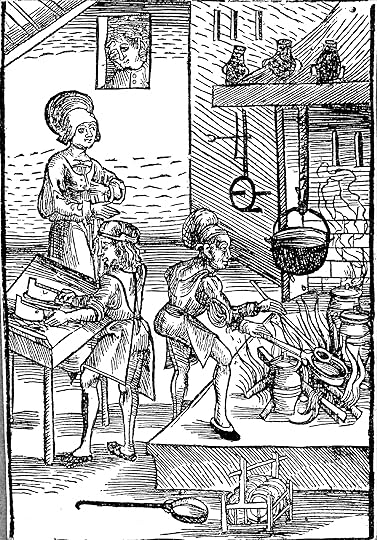
A housewife with cooks, c1516. (INTERFOTO/Alamy Stock Photo)
Other girls were formally apprenticed to a master, such as Helen ap Richard, who arrived in Bristol in October 1542 to be taught for seven years by a seamstress. She was to work with her mistress in learning how to cut, fashion and fit clothes so that she too could earn her living. Many of the trades to which girls were apprenticed were feminine, such as housewifery. However, others learned more masculine trades, such as pin-making. Wives, too, were expected to participate in their husbands’ trades, while widows often took over the business. Katherine Fenkyll, the widow of a London draper, took on her husband’s trading business, while also rising to prominence in the Draper’s Company in the early 16th century.
Others took on a less respectable trade, with prostitution rife in the towns of Tudor England. The scale of such operations – which were often run by women – was variable. One winter’s evening in 1567, Mistress Cooe of Chelmsford in Essex was leaving church when she received word that her husband, Henry, had been seen entering the house of Mother Bowden nearby. Furious, the angry wife marched over to the house, where her husband fled via a back door. This left Mother Bowden, who had by then opened the front entrance, “and the harlot her [Bowden’s] daughter”, to face the wrath of Mrs Cooe. She beat Mother Bowden, before grabbing the younger woman by the hair and dragging her about the house. Both Henry Cooe and Mother Bowden were later charge with immorality by the parish officials.
Love and marriageMost Tudor women expected to marry, and girls were expected to retain their virginity until their wedding night.
Jane Singleton from Halsall in Lancashire thought that she had done everything right when a young gentleman came courting. She arranged for a local man to go with her to the church one afternoon in 1558, to witness her marriage. The couple stood together at the altar as her suitor took Jane by the hand, telling her that “I Gilbert take thee Jane to be my wedded wife and thereto I plight thee my troth”. She replied in similar fashion, before the couple spent the night together.
To Jane’s dismay, however, her husband promptly abandoned her, so she was forced to petition the church courts at Chester for them to uphold the marriage. Technically, the pair did not even need to plight their troths in church, since all that was required for a valid marriage in the Tudor period was a mutual promise to wed and consummation. Jane was, however, lucky to have a witness.
Marriage was considerably less informal higher up the social scale. Marriages of the nobility and gentry were approached like business arrangements, with the two families haggling over the terms. Sir William Locke, a prominent London Alderman and merchant, insisted on seeing the account books of one prospective son-in-law, Anthony Hickman, only being content to allow him to wed his daughter, Rose, when he proved to be worth £1,000.
And for a girl such as Elizabeth Howard, who was the daughter of the Earl of Surrey, it was essential that she maintained or even furthered her social position, as well as obtaining financial security. In the last years of the 15th century, when Elizabeth was approaching 20, her parents arranged a marriage for her with young Thomas Boleyn. This was a solid, respectable match, with Thomas’s father agreeing to settle a number of manors on Elizabeth as her jointure. In return, her father provided a dowry.
Tudor women were expected to support their husbands in their businesses or work, run their households and bear children. Domestic skills were essential. One contemporary writer considered that a woman who could not cook was a woman who had broken her marriage vows: “She may love and obey, but she cannot serve and keep him with that true duty which is ever expected”. Not all were content to remain in a domestic sphere, however. With Henry VIII’s Reformation and the religious changes that it wrought, some women spoke out against the authorities regarding their faith.
Anne Askew, a gentlewoman who left her husband and children to preach the gospel, was burned towards the end of Henry VIII’s reign, while her friend – the equally outspoken Joan Bocher – was one of only two Protestants to be burned for heresy under the Protestant Edward VI.
During his reign the king’s Catholic half-sister, Princess Mary, considered her religion so under threat that she came close to fleeing England. Then during her own reign a few years later, Princess Mary burned both men and women for heresy. These included Cicely Ormes, who was inspired to become a martyr while watching the burning of two Protestants in Norwich in 1557.
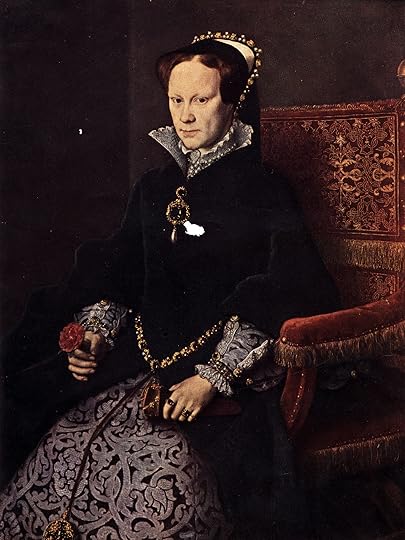
Mary I, c1553. (Photo by Hulton Archive/Getty Images)
This 32-year-old wife of a weaver was “a very simple woman” who could not even write her name. She was, however, troubled by her earlier recantation of her Protestant beliefs. As she watched the burnings, she suddenly cried out that “she would pledge them of the same cup that they drank on”, before being arrested. She was burned on 23 September 1557, on a stake still black with soot from the earlier execution she had witnessed.
Others had less stomach for martyrdom. The Protestant Rose Hickman, whose father had so carefully scrutinised her fiancé’s account books, went into voluntarily exile in Antwerp during Mary’s reign. She and her husband selected that Catholic city primarily to ensure that they could still carry out their lucrative merchant trading business. The future Elizabeth I, too, agreed to attend mass during her half-sister’s reign, although she infuriated the queen by declaring that her stomach hurt throughout the service.
Old ageDeath could come suddenly in Tudor England, while old age seemed a poor reward for the survivors. This was particularly the case for old women. One wildly popular text cautioned readers to keep such crones away from infants, since they could “poison the eyes of children lying in their cradles by their glance”. All women, readers were told, were “entirely venomous”, but menstrual blood at least served to dilute these evil humours. With the menopause, the poison was left to stew fetid in the body, with the worst toxins escaping malignantly through wrinkled eyes.
Such women were also vulnerable to accusations of witchcraft, such as elderly Alice Samuel of Warboys in Huntingdonshire, who was accused of bewitching the five daughters of her next-door neighbour in 1589. Nothing that Alice could do could clear her name, with her every look or utterance raising suspicion among the town authorities. She was eventually hanged.
Many elderly women faced extreme financial hardship, with no prospect of retirement. In Norwich in 1570 an 80-year-old widow named Elizabeth Menson was described as “a lame woman of one hand”, perhaps having suffered a stroke, but was still able to eke out a living with her spinning. She could also wind wool for money with one hand. For those who could not work, there was always charity, with a number of institutions, such as St Bartholomew’s Hospital in London being reopened in the period for the care of the aged and infirm.
Even Elizabeth I, whose wealth and status protected her from the hardships of old age, rued the passing of time, attempting to hold on to her youthful looks with cosmetics, wigs and ever-more elaborate clothing. It had some effect, according to one visitor to her court in 1602: “Even in her old age she did not look ugly, when seen from a distance”. Nonetheless, Elizabeth I was a great survivor. The Tudor dynasty ended with her – a woman – in 1603.
Elizabeth Norton is a historian of the queens of England and the Tudor period. She is the author of biographies of Anne Boleyn, Jane Seymour, Anne of Cleves and Catherine Parr, and of England's Queens: The Biography.
Her forthcoming book, The Lives Of Tudor Women, will be published by Head of Zeus on 3 November 2016

A midwife and friend attend to a woman giving birth at home, c1513. The original artwork is an illustration from Rosslin's 'Der Wanglien Frauer and Hebammen Kofegarter'. (Photo by Hulton Archive/Getty Images)
In her forthcoming book, historian Elizabeth Norton explores the seven ages of the Tudor woman, from childhood to old age, through the diverging examples of women such as Elizabeth Tudor, Henry VIII's sister who died in infancy; Cecily Burbage, Elizabeth's wet nurse; and Elizabeth Barton, a peasant girl who would be lauded as a prophetess. Their stories are interwoven with studies of topics ranging from Tudor toys to contraception to witchcraft.
Here, writing for History Extra, the author of The Lives Of Tudor Women reveals how women at all levels made their mark on society, commerce and in the home…
BirthConception and then birth were, of course, the first life stage for all Tudor women. They were also important events for adult women in the period, most of whom would have expected to become mothers. Pregnancy, however, was notoriously difficult to diagnose. Could a woman’s symptoms merely be “her natural sickness or store of water”, one contemporary medical text suggested? Alternatively, an increase in girth could be due to “some windy matter” and not an expected baby. Indeed, few physicians were prepared to confirm their diagnosis until the child actually began to stir in the womb. A mistake could be highly embarrassing for all concerned, and so for months women were left on tenterhooks.
Once pregnancy was established, however, a woman was advised to spend time in “good tempered air”. Even queens adapted their existing clothes, with extra panels added to their dresses. They could supplement this with more specific maternity wear, such as ‘self grow’ waistcoats, kirtles and gowns that could be let out as the wearer’s pregnancy advanced. More simply, a gown could first be unlaced, before more drastic changes were required.
Thoughts would then turn to the birth. For royalty, there was an elaborate ceremonial to follow, with the queen retiring to her chamber a month before the expected birth. Poorer women, too, made preparations, with birthing sheets sometimes passed down through families from mother to daughter.
Some women were taken entirely by surprise, however. Little Mary Cheese of Hounslow in Surrey was unfortunate enough to be born while her mother was out walking in town in March 1573. The birth was so sudden that Mary Cheese suffered a fatal head injury as she fell to the floor beneath her mother’s skirts.
Just over 80 years before, Queen Elizabeth of York gave birth to her fourth child – a daughter named Elizabeth – who was immediately handed to a wetnurse and a team of cradle rockers, who had been engaged in advance of the birth. Elizabeth was taken to the royal nursery where she, like all children, later spent her time at play. For wealthy children there were dolls, rattles, windmills and hobbyhorses, while the parents of poorer children fashioned more makeshift toys.
In spite of this fun, infancy was always a perilous time. Princess Elizabeth died in September 1495 at the age of three from unspecified causes. Many of her peers also failed to reach adulthood.
EducationAlthough the lawyer, scholar and chancellor Thomas More famously gave his daughters a fine education, most Tudor parents were less enlightened. The educationalist Richard Mulcaster, addressing the issue in the 1580s, was quick to assure his readers that he would speak of boys’ education first, since “naturally the male is more worthy”. Nonetheless, he did acknowledge that girls had some capacity to learn.
By the start of the 16th century, girls were commonly attending local schools along with their male peers. There was one such school in London between 1504 and 1515, which was run by an aged priest named William Barbour. Barbour took in 30 students of both sexes, teaching them both religious doctrine and “further learning”. Many other such schools are also known. Even the very poorest girls in Norwich in the 1560s went to school, although their evenings were spent spinning to help support their families. No girls were permitted to attend university, but a handful attended grammar schools.
Most teenagers in the Tudor period were expected to leave home and enter service. For upper-class girls this would be the home of a social superior, who was expected to patronise them and help find them a husband. For those of lower or middling status, leaving home meant agreeing to a year’s service in exchange for wages and board. Most would be expected to carry out household or agricultural tasks.

A housewife with cooks, c1516. (INTERFOTO/Alamy Stock Photo)
Other girls were formally apprenticed to a master, such as Helen ap Richard, who arrived in Bristol in October 1542 to be taught for seven years by a seamstress. She was to work with her mistress in learning how to cut, fashion and fit clothes so that she too could earn her living. Many of the trades to which girls were apprenticed were feminine, such as housewifery. However, others learned more masculine trades, such as pin-making. Wives, too, were expected to participate in their husbands’ trades, while widows often took over the business. Katherine Fenkyll, the widow of a London draper, took on her husband’s trading business, while also rising to prominence in the Draper’s Company in the early 16th century.
Others took on a less respectable trade, with prostitution rife in the towns of Tudor England. The scale of such operations – which were often run by women – was variable. One winter’s evening in 1567, Mistress Cooe of Chelmsford in Essex was leaving church when she received word that her husband, Henry, had been seen entering the house of Mother Bowden nearby. Furious, the angry wife marched over to the house, where her husband fled via a back door. This left Mother Bowden, who had by then opened the front entrance, “and the harlot her [Bowden’s] daughter”, to face the wrath of Mrs Cooe. She beat Mother Bowden, before grabbing the younger woman by the hair and dragging her about the house. Both Henry Cooe and Mother Bowden were later charge with immorality by the parish officials.
Love and marriageMost Tudor women expected to marry, and girls were expected to retain their virginity until their wedding night.
Jane Singleton from Halsall in Lancashire thought that she had done everything right when a young gentleman came courting. She arranged for a local man to go with her to the church one afternoon in 1558, to witness her marriage. The couple stood together at the altar as her suitor took Jane by the hand, telling her that “I Gilbert take thee Jane to be my wedded wife and thereto I plight thee my troth”. She replied in similar fashion, before the couple spent the night together.
To Jane’s dismay, however, her husband promptly abandoned her, so she was forced to petition the church courts at Chester for them to uphold the marriage. Technically, the pair did not even need to plight their troths in church, since all that was required for a valid marriage in the Tudor period was a mutual promise to wed and consummation. Jane was, however, lucky to have a witness.
Marriage was considerably less informal higher up the social scale. Marriages of the nobility and gentry were approached like business arrangements, with the two families haggling over the terms. Sir William Locke, a prominent London Alderman and merchant, insisted on seeing the account books of one prospective son-in-law, Anthony Hickman, only being content to allow him to wed his daughter, Rose, when he proved to be worth £1,000.
And for a girl such as Elizabeth Howard, who was the daughter of the Earl of Surrey, it was essential that she maintained or even furthered her social position, as well as obtaining financial security. In the last years of the 15th century, when Elizabeth was approaching 20, her parents arranged a marriage for her with young Thomas Boleyn. This was a solid, respectable match, with Thomas’s father agreeing to settle a number of manors on Elizabeth as her jointure. In return, her father provided a dowry.
Tudor women were expected to support their husbands in their businesses or work, run their households and bear children. Domestic skills were essential. One contemporary writer considered that a woman who could not cook was a woman who had broken her marriage vows: “She may love and obey, but she cannot serve and keep him with that true duty which is ever expected”. Not all were content to remain in a domestic sphere, however. With Henry VIII’s Reformation and the religious changes that it wrought, some women spoke out against the authorities regarding their faith.
Anne Askew, a gentlewoman who left her husband and children to preach the gospel, was burned towards the end of Henry VIII’s reign, while her friend – the equally outspoken Joan Bocher – was one of only two Protestants to be burned for heresy under the Protestant Edward VI.
During his reign the king’s Catholic half-sister, Princess Mary, considered her religion so under threat that she came close to fleeing England. Then during her own reign a few years later, Princess Mary burned both men and women for heresy. These included Cicely Ormes, who was inspired to become a martyr while watching the burning of two Protestants in Norwich in 1557.

Mary I, c1553. (Photo by Hulton Archive/Getty Images)
This 32-year-old wife of a weaver was “a very simple woman” who could not even write her name. She was, however, troubled by her earlier recantation of her Protestant beliefs. As she watched the burnings, she suddenly cried out that “she would pledge them of the same cup that they drank on”, before being arrested. She was burned on 23 September 1557, on a stake still black with soot from the earlier execution she had witnessed.
Others had less stomach for martyrdom. The Protestant Rose Hickman, whose father had so carefully scrutinised her fiancé’s account books, went into voluntarily exile in Antwerp during Mary’s reign. She and her husband selected that Catholic city primarily to ensure that they could still carry out their lucrative merchant trading business. The future Elizabeth I, too, agreed to attend mass during her half-sister’s reign, although she infuriated the queen by declaring that her stomach hurt throughout the service.
Old ageDeath could come suddenly in Tudor England, while old age seemed a poor reward for the survivors. This was particularly the case for old women. One wildly popular text cautioned readers to keep such crones away from infants, since they could “poison the eyes of children lying in their cradles by their glance”. All women, readers were told, were “entirely venomous”, but menstrual blood at least served to dilute these evil humours. With the menopause, the poison was left to stew fetid in the body, with the worst toxins escaping malignantly through wrinkled eyes.
Such women were also vulnerable to accusations of witchcraft, such as elderly Alice Samuel of Warboys in Huntingdonshire, who was accused of bewitching the five daughters of her next-door neighbour in 1589. Nothing that Alice could do could clear her name, with her every look or utterance raising suspicion among the town authorities. She was eventually hanged.
Many elderly women faced extreme financial hardship, with no prospect of retirement. In Norwich in 1570 an 80-year-old widow named Elizabeth Menson was described as “a lame woman of one hand”, perhaps having suffered a stroke, but was still able to eke out a living with her spinning. She could also wind wool for money with one hand. For those who could not work, there was always charity, with a number of institutions, such as St Bartholomew’s Hospital in London being reopened in the period for the care of the aged and infirm.
Even Elizabeth I, whose wealth and status protected her from the hardships of old age, rued the passing of time, attempting to hold on to her youthful looks with cosmetics, wigs and ever-more elaborate clothing. It had some effect, according to one visitor to her court in 1602: “Even in her old age she did not look ugly, when seen from a distance”. Nonetheless, Elizabeth I was a great survivor. The Tudor dynasty ended with her – a woman – in 1603.
Elizabeth Norton is a historian of the queens of England and the Tudor period. She is the author of biographies of Anne Boleyn, Jane Seymour, Anne of Cleves and Catherine Parr, and of England's Queens: The Biography.
Her forthcoming book, The Lives Of Tudor Women, will be published by Head of Zeus on 3 November 2016
Published on July 03, 2016 03:00
July 2, 2016
Game of Thrones season six: the real-life medieval history
History Extra
 Maisie Williams as Arya Stark in the sixth season of Game of Thrones, which airs on Sunday (Monday morning in Britain). © 2016 Home Box Office, Inc.
Maisie Williams as Arya Stark in the sixth season of Game of Thrones, which airs on Sunday (Monday morning in Britain). © 2016 Home Box Office, Inc.
George RR Martin, author of the books upon which the Game of Thrones television show is based, notes that the battle for the Iron Throne is loosely based on the 15th-century Wars of the Roses; the chime of Stark and York and Lannister and Lancaster suggests as much. But Martin draws much more eclectically on medieval cultures, as the following examples demonstrate.
Queen CerseiCersei has been compared to a good number of medieval queens, such as Margaret of Anjou (d1482), wife of Henry VI. To my mind, though, Cersei, the “green-eyed lioness” of the Lannisters, is much more like Edward II’s queen Isabella, the ‘She-Wolf of France’. Daughter of King Philip IV (the Fair) of France, Isabella was sister of his three successors. She was married, probably aged 12, to Edward II of England in 1308. Edward gave her four children, but, notoriously, he neglected her for his good-looking male favourites.
His barons forced Edward to give up one of these favourites, Piers Gaveston, 1st Earl of Cornwall, who was executed in 1312, but by 1320 Edward was deeply involved with Hugh Despenser the Younger. As a consequence of Isabella’s hostility to the Despenser faction, her lands in England were taken from her, as were her children, and her household was broken up.
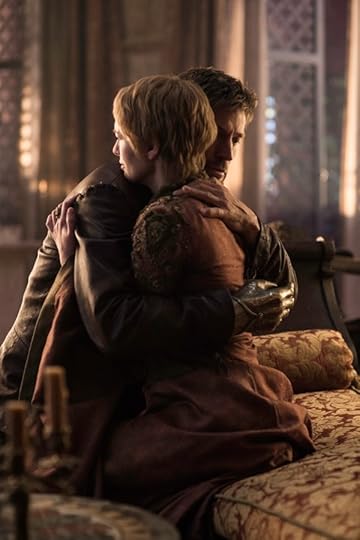
Cersei Lannister played by Lena Headey and Jaime Lannister played by Nikolaj Coster-Waldau. ©2015 Home Box Office, Inc.
Isabella and Edward had effectively separated. When, in 1325, her eldest son, the future Edward III, went to France to do homage for the province of Gascony, which the English crown held from the French king, the queen seized her chance. In Paris Isabella took the exiled English lord Roger Mortimer as her lover, and they plotted against her husband.
Young Edward was promised in marriage to Philippa, daughter of William, Count of Hainault, in the Low Countries. In return William provided men and an advance on Philippa’s dowry. Borrowing heavily from Italian banking houses, Isabella, her son and Mortimer invaded England in 1326 and Edward II was overthrown. How far Isabella was complicit in her husband’s horrible death in 1327 isn’t clear, but she and Mortimer ruled England for the next four years.
In 1330 her son, Edward III, took charge of the kingdom, imprisoning his mother and executing her lover. Perhaps King Tommen will similarly assert himself against his mother in this sixth season?

Isabella of France, aka the 'She-Wolf of France', queen consort of Edward II of England. From the book ‘Our Queen Mothers’ by Elizabeth Villiers, c1800. (Photo by Universal History Archive/Getty Images)
The Iron Bank of Braavos and the SparrowsThe parallels between Isabella and Cersei are striking: adultery, complicity in their husbands’ deaths and attempts to rule through their sons. Isabella and Mortimer were able to raise funds for their expedition from the Italian bankers because Edward II had defaulted on his debts to them; Isabella and Edward III promised to resume repayments.
Just so, the Iron Bank of Braavos was ready to support Stannis against Tommen, once Cersei had defaulted on the huge sums owed to the Bank. The Crown’s financial crisis also drove Cersei to strike a deal with the Sparrows, the fanatical grassroots movement that has taken over the Faith, and to allow them to arm themselves in return for forgetting the money the Crown had borrowed.
The Sparrows resemble the Franciscan movement, founded by St Francis in around 1209. The Franciscans sought to return to a simpler, less money-obsessed form of Christianity. Franciscan brothers (friars) were sworn to poverty and wandered from place to place preaching the Gospel to ordinary folk in language they could understand. The Sparrows of the Faith, however, combine their contempt for riches with a strict sexual morality and with the power, like that of the Inquisition, to compel sinners into religious courts and to punish them for their offences – as Cersei and Margaery have discovered.

c1220, a portrait of Saint Francis of Assisi kneeling at an rock altar to pray with a skull in his hand. (Photo by Archive Photos/Getty Images)
The IronbornWe haven’t seen much of the Ironborn, the Westerosi sea-borne warriors, since season four. Fierce piratical fighters, depending on their swift, stable and beautifully designed longships for speed and manoeuvrability, the Ironborn live by raiding their neighbours and by selling their captives into slavery in Volantis. So too the Vikings (9th-11th centuries) depended on their longships to raid along the coasts of Europe, journeying down the rivers of Russia to the Black Sea, around the Mediterranean, and of course across the North Sea to the British Isles.
We tend to think of the Vikings as mostly interested in easily portable plunder, but in fact they were active in the European slave trade. One Icelandic saga relates how a beautiful slave-woman was acquired by an Icelander at the market on an island off southern Sweden. Melkorka turned out to be the daughter of an Irish king and her son became one of the richest men in Iceland.
Vikings exploited the market for blond-haired, well-educated slaves in the Greek empire. They raided in the Baltic territories and sold their Slav captives in Constantinople: the origin of our word ‘slave’. Vikings were also farmers and traders as well as raiders; the Word of House Greyjoy, ‘We Do Not Sow’, would not have resonated with those Vikings who lived long enough to settle with a wife and family wherever they could find land, in Scandinavia, northern Britain, Ireland or Iceland.
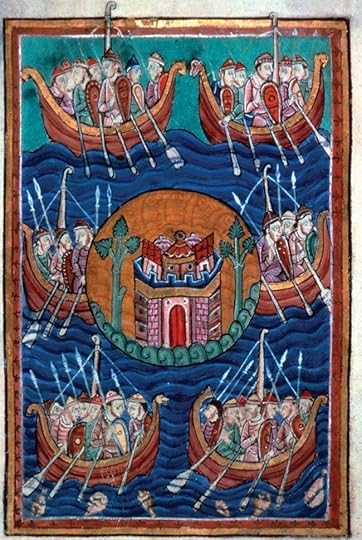
Viking ships arriving in Britain, c1130. Found in the collection of Pierpont Morgan Library. Artist: Abbo of Fleury. (Photo by Fine Art Images/Heritage Images/Getty Images)
The DothrakiAfter a long absence from Game of Thrones the Dothraki are set to return. Loosely based on the central Asian Mongol peoples, these copper-skinned nomadic warriors are also involved in slaving and raiding around the grasslands of the Dothraki Sea.
The Mongols ruled over the largest land empire the world has ever seen, from the Pacific Ocean to Hungary. Western churchmen often visited them during the 13th century, bringing letters from western kings and from the pope. The friars wrote detailed accounts of their journeys, relating how difficult the weather was and how strange the food and drink. Fermented mare’s milk, or kumiss, was a poor substitute for wine, though they liked the spicy horsemeat sausages.
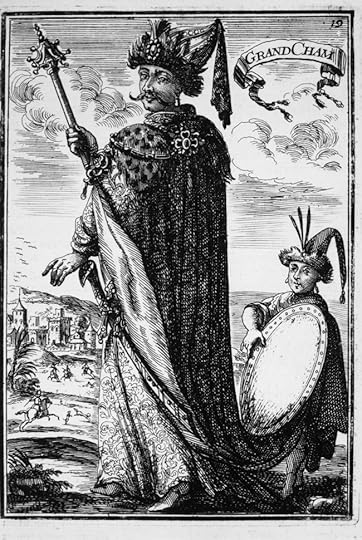
Genghis Khan, Mongol ruler, originally named Temujin, 1683 Woodcut. (Photo by Universal History Archive/UIG via Getty Images)
The Mongols held all other peoples in contempt, reports one writer. Hearing about the kingdom of France, they asked “whether there were many sheep and cattle and horses there, and whether they had not better go there at once and take it all”. Will the Dothraki who have captured Daenerys be quite so ambitious? Khal Drogo swore to take his men in the “wooden horses” (ships) to attack Westeros and capture the Iron Throne for his beloved wife, but traditionally the Dothraki have never sailed across the Narrow Sea.
Overall, then, Game of Thrones’ extraordinary hold on people’s imaginations has much to do with the way it harnesses mythology and legend: archetypes such as the dragons and the Three-Eyed Raven; the tales of lost children and reanimated corpses. Yet it’s the realness of the re-imagined medieval pasts it brings so vividly to life that makes viewers believe in Essos, the Seven Kingdoms and the battle for the Iron Throne.
Carolyne Larrington teaches medieval English literature at St John’s College, Oxford. She is the author of Winter is Coming: The Medieval World of Game of Thrones (IB Tauris, November 2015).
 Maisie Williams as Arya Stark in the sixth season of Game of Thrones, which airs on Sunday (Monday morning in Britain). © 2016 Home Box Office, Inc.
Maisie Williams as Arya Stark in the sixth season of Game of Thrones, which airs on Sunday (Monday morning in Britain). © 2016 Home Box Office, Inc. George RR Martin, author of the books upon which the Game of Thrones television show is based, notes that the battle for the Iron Throne is loosely based on the 15th-century Wars of the Roses; the chime of Stark and York and Lannister and Lancaster suggests as much. But Martin draws much more eclectically on medieval cultures, as the following examples demonstrate.
Queen CerseiCersei has been compared to a good number of medieval queens, such as Margaret of Anjou (d1482), wife of Henry VI. To my mind, though, Cersei, the “green-eyed lioness” of the Lannisters, is much more like Edward II’s queen Isabella, the ‘She-Wolf of France’. Daughter of King Philip IV (the Fair) of France, Isabella was sister of his three successors. She was married, probably aged 12, to Edward II of England in 1308. Edward gave her four children, but, notoriously, he neglected her for his good-looking male favourites.
His barons forced Edward to give up one of these favourites, Piers Gaveston, 1st Earl of Cornwall, who was executed in 1312, but by 1320 Edward was deeply involved with Hugh Despenser the Younger. As a consequence of Isabella’s hostility to the Despenser faction, her lands in England were taken from her, as were her children, and her household was broken up.

Cersei Lannister played by Lena Headey and Jaime Lannister played by Nikolaj Coster-Waldau. ©2015 Home Box Office, Inc.
Isabella and Edward had effectively separated. When, in 1325, her eldest son, the future Edward III, went to France to do homage for the province of Gascony, which the English crown held from the French king, the queen seized her chance. In Paris Isabella took the exiled English lord Roger Mortimer as her lover, and they plotted against her husband.
Young Edward was promised in marriage to Philippa, daughter of William, Count of Hainault, in the Low Countries. In return William provided men and an advance on Philippa’s dowry. Borrowing heavily from Italian banking houses, Isabella, her son and Mortimer invaded England in 1326 and Edward II was overthrown. How far Isabella was complicit in her husband’s horrible death in 1327 isn’t clear, but she and Mortimer ruled England for the next four years.
In 1330 her son, Edward III, took charge of the kingdom, imprisoning his mother and executing her lover. Perhaps King Tommen will similarly assert himself against his mother in this sixth season?

Isabella of France, aka the 'She-Wolf of France', queen consort of Edward II of England. From the book ‘Our Queen Mothers’ by Elizabeth Villiers, c1800. (Photo by Universal History Archive/Getty Images)
The Iron Bank of Braavos and the SparrowsThe parallels between Isabella and Cersei are striking: adultery, complicity in their husbands’ deaths and attempts to rule through their sons. Isabella and Mortimer were able to raise funds for their expedition from the Italian bankers because Edward II had defaulted on his debts to them; Isabella and Edward III promised to resume repayments.
Just so, the Iron Bank of Braavos was ready to support Stannis against Tommen, once Cersei had defaulted on the huge sums owed to the Bank. The Crown’s financial crisis also drove Cersei to strike a deal with the Sparrows, the fanatical grassroots movement that has taken over the Faith, and to allow them to arm themselves in return for forgetting the money the Crown had borrowed.
The Sparrows resemble the Franciscan movement, founded by St Francis in around 1209. The Franciscans sought to return to a simpler, less money-obsessed form of Christianity. Franciscan brothers (friars) were sworn to poverty and wandered from place to place preaching the Gospel to ordinary folk in language they could understand. The Sparrows of the Faith, however, combine their contempt for riches with a strict sexual morality and with the power, like that of the Inquisition, to compel sinners into religious courts and to punish them for their offences – as Cersei and Margaery have discovered.

c1220, a portrait of Saint Francis of Assisi kneeling at an rock altar to pray with a skull in his hand. (Photo by Archive Photos/Getty Images)
The IronbornWe haven’t seen much of the Ironborn, the Westerosi sea-borne warriors, since season four. Fierce piratical fighters, depending on their swift, stable and beautifully designed longships for speed and manoeuvrability, the Ironborn live by raiding their neighbours and by selling their captives into slavery in Volantis. So too the Vikings (9th-11th centuries) depended on their longships to raid along the coasts of Europe, journeying down the rivers of Russia to the Black Sea, around the Mediterranean, and of course across the North Sea to the British Isles.
We tend to think of the Vikings as mostly interested in easily portable plunder, but in fact they were active in the European slave trade. One Icelandic saga relates how a beautiful slave-woman was acquired by an Icelander at the market on an island off southern Sweden. Melkorka turned out to be the daughter of an Irish king and her son became one of the richest men in Iceland.
Vikings exploited the market for blond-haired, well-educated slaves in the Greek empire. They raided in the Baltic territories and sold their Slav captives in Constantinople: the origin of our word ‘slave’. Vikings were also farmers and traders as well as raiders; the Word of House Greyjoy, ‘We Do Not Sow’, would not have resonated with those Vikings who lived long enough to settle with a wife and family wherever they could find land, in Scandinavia, northern Britain, Ireland or Iceland.

Viking ships arriving in Britain, c1130. Found in the collection of Pierpont Morgan Library. Artist: Abbo of Fleury. (Photo by Fine Art Images/Heritage Images/Getty Images)
The DothrakiAfter a long absence from Game of Thrones the Dothraki are set to return. Loosely based on the central Asian Mongol peoples, these copper-skinned nomadic warriors are also involved in slaving and raiding around the grasslands of the Dothraki Sea.
The Mongols ruled over the largest land empire the world has ever seen, from the Pacific Ocean to Hungary. Western churchmen often visited them during the 13th century, bringing letters from western kings and from the pope. The friars wrote detailed accounts of their journeys, relating how difficult the weather was and how strange the food and drink. Fermented mare’s milk, or kumiss, was a poor substitute for wine, though they liked the spicy horsemeat sausages.

Genghis Khan, Mongol ruler, originally named Temujin, 1683 Woodcut. (Photo by Universal History Archive/UIG via Getty Images)
The Mongols held all other peoples in contempt, reports one writer. Hearing about the kingdom of France, they asked “whether there were many sheep and cattle and horses there, and whether they had not better go there at once and take it all”. Will the Dothraki who have captured Daenerys be quite so ambitious? Khal Drogo swore to take his men in the “wooden horses” (ships) to attack Westeros and capture the Iron Throne for his beloved wife, but traditionally the Dothraki have never sailed across the Narrow Sea.
Overall, then, Game of Thrones’ extraordinary hold on people’s imaginations has much to do with the way it harnesses mythology and legend: archetypes such as the dragons and the Three-Eyed Raven; the tales of lost children and reanimated corpses. Yet it’s the realness of the re-imagined medieval pasts it brings so vividly to life that makes viewers believe in Essos, the Seven Kingdoms and the battle for the Iron Throne.
Carolyne Larrington teaches medieval English literature at St John’s College, Oxford. She is the author of Winter is Coming: The Medieval World of Game of Thrones (IB Tauris, November 2015).
Published on July 02, 2016 03:00
July 1, 2016
Among The Dead: My Years in The Port Mortuary by John W. Harper

The author served twenty-one years in the United States Air Force and was Honorably Retired in 2006. His final assignment was at Dover Air Force Base, Delaware where he served with the Dental Evidence Response Team at the Dover Port Mortuary. This book details those years following September 11th which involved forensic dental identifications on those killed in the Pentagon Disaster, and then the thousands of fallen heroes returning from the battlefields of Iraq. The author provides an inside look at how exposure to human remains affected the team, and their individual battles with post-traumatic stress disorder. It is noteworthy that the teams' efforts were always directed by dignity, honor and respect for the fallen heroes. This work is meant as documentation, as well as some closure for those team members who continue to suffer the symptoms of PTSD. The author holds a Master's Degree from Old Dominion University in Norfolk, Virginia. Today he lives with his wife and cat, just south of Orlando, Florida.

Amazon Link
What people are saying:
I knew John and his team had a terrible assignment after 9-11 By Amazon Customer on May 27, 2016Format: Paperback Verified Purchase What a thought provoking read! I knew John and his team had a terrible assignment after 9-11, but this makes us understand the extent of the lasting effect it has had on him and his team. I also never knew of the respect and care that was given to the soldiers before their return to their loved ones. I hope this book helps to ease the pain of others that are having the same struggles. I am proud to say that the author is a friend and a true hero to many.
Debbie Buterbaugh - PA
The Author is a next door neighbor so reading the ... By Mary Ellen on May 28, 2016Format: Paperback Verified Purchase The Author is a next door neighbor so reading the book was both necessary and a pleasure to understand this outstanding individual. I learned so much about the trauma's he and his team went through at Dover AFB. I admire his sharing his career in the Air Force and especially his tour of duty at the Port Mortuary. Please everybody read this book.
Outstanding read! Really opened my eyes on how you ... By Amazon Customer on May 16, 2016Format: Paperback Outstanding read! Really opened my eyes on how you should treat other people, because you never no what someone else is going through! Reminds us all to treat each other with dignity and respect.
Published on July 01, 2016 08:11
Archaeologists Find Pompeii Victims Who Perished in a Shop
Ancient Origins
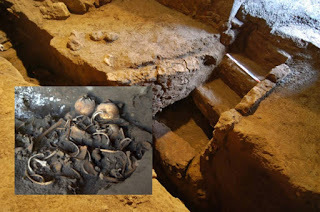
Archaeologists carrying out excavations on the outskirts of the Roman city of Pompeii have discovered the remains of four people in the ruins of an ancient shop. It is believed that they had gathered in the shop to seek shelter from the violent eruption of Mount Vesuvius, when it erupted in 79 A.D., burying the city in ashes.
The discovery was made by an Italian and French archaeological team, who were excavating a site at Porta Ercolano, located on the outskirts of Pompeii on a road leading to Herculaneum.
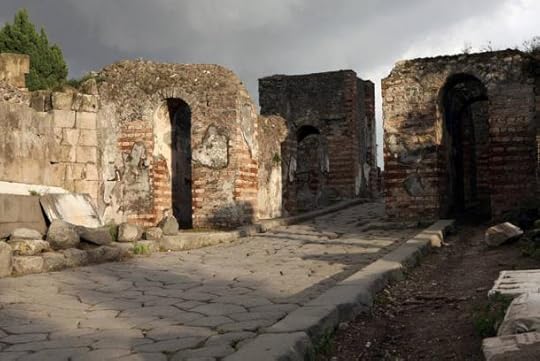 View of the northwest gate of Pompeii, the Porta Ercolano, leading to Herculaneum (
Roger Ulrich / Flickr
)A City Frozen in TimePompeii was an ancient Roman city near modern-day Naples in Italy, which was wiped out and buried under 6 metres of ash and pumice following the eruption of Mount Vesuvius in 79 AD. It is an eerie feeling to walk the empty streets of Pompeii and to view shops and homes left virtually untouched for nearly two millennia.
View of the northwest gate of Pompeii, the Porta Ercolano, leading to Herculaneum (
Roger Ulrich / Flickr
)A City Frozen in TimePompeii was an ancient Roman city near modern-day Naples in Italy, which was wiped out and buried under 6 metres of ash and pumice following the eruption of Mount Vesuvius in 79 AD. It is an eerie feeling to walk the empty streets of Pompeii and to view shops and homes left virtually untouched for nearly two millennia.
When archaeologists discovered the ancient city, they found the city almost entirely intact – loaves of bread still sat in the oven, the remains of meals remained discarded on the pavement, and the bodies of men, women, children, and pets were found frozen in their last moments, the expressions of fear still etched on their faces.
Frozen in Time: Casts of Pompeii Reveal Last Moments of Volcano Victims The Houses of Pleasure in Ancient Pompeii Giraffe and Sea Urchin on the Menu for People of Pompeii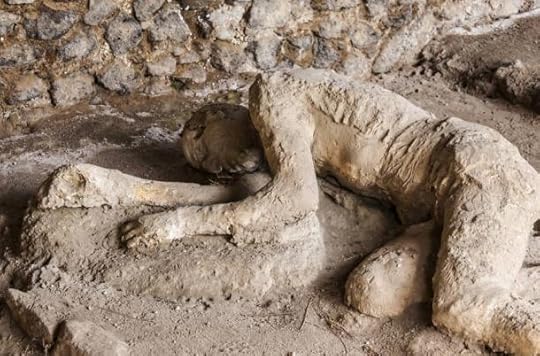 A Pompeii victim frozen in time. Source: BigStockPhotoNew Victims FoundAccording to a press release put out by the Archaeological Superintendency of Pompeii, the newly discovered victims are of four young people, including an adolescent girl, who may have become trapped in the shop during the volcanic eruption.
A Pompeii victim frozen in time. Source: BigStockPhotoNew Victims FoundAccording to a press release put out by the Archaeological Superintendency of Pompeii, the newly discovered victims are of four young people, including an adolescent girl, who may have become trapped in the shop during the volcanic eruption.
Although many victims of the disaster were preserved in their moments of death by the pyroclastic flows bursting from Vesuvius, all that remained of the four individuals is a scattered pile of bones.
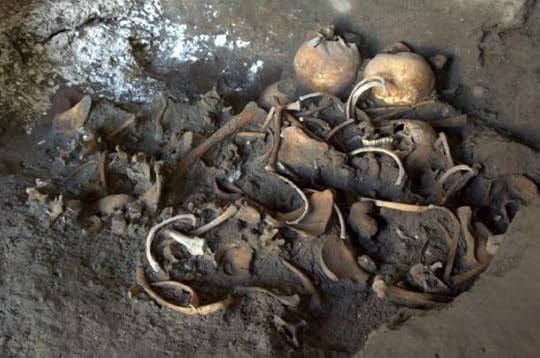 Skeletons found in a shop near the Porto Ercolano at Pompeii. (Image credit:
Soprintendenza Pompei
)Three gold coins dated to 74-78 AD and a necklace with a gold-leaf pendant in the shape of a flower were scattered among the remains.
Skeletons found in a shop near the Porto Ercolano at Pompeii. (Image credit:
Soprintendenza Pompei
)Three gold coins dated to 74-78 AD and a necklace with a gold-leaf pendant in the shape of a flower were scattered among the remains.
Extremely rare discovery of Pre-Roman tomb in Pompeii will shed light on its early history New Scans of Ancient Pompeii Victims Reveal Great Teeth and Good Health 2,000-Year-Old Public Laundry in Pompeii, Restored and Opened to the Public for the First Time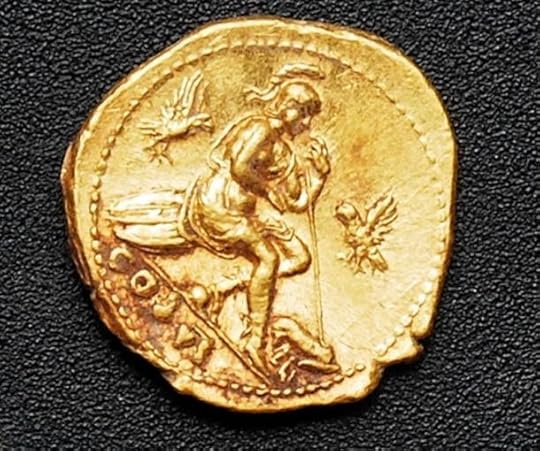 One of the gold coins discovered among the bodies. (Image credit:
Soprintendenza Pompei
)The research team is not sure what kind of business operated in the shop. It features a circular well that is accessed by a spiral staircase and a furnace. One theory is that it may have been used to make bronze objects.
One of the gold coins discovered among the bodies. (Image credit:
Soprintendenza Pompei
)The research team is not sure what kind of business operated in the shop. It features a circular well that is accessed by a spiral staircase and a furnace. One theory is that it may have been used to make bronze objects.
 The circular well accessed by a staircase. (Image credit:
Soprintendenza Pompei
)“This new find offers archaeologists a unique opportunity to connect four people attempting to protect themselves from Vesuvius with a particular place,” writes Forbes “which may allow us to get deeper insight into who these Pompeiians were and what their short lives were like.”
The circular well accessed by a staircase. (Image credit:
Soprintendenza Pompei
)“This new find offers archaeologists a unique opportunity to connect four people attempting to protect themselves from Vesuvius with a particular place,” writes Forbes “which may allow us to get deeper insight into who these Pompeiians were and what their short lives were like.”
Top image: Main: The excavated shop. Inset: Skeletons found in a shop near the Porto Ercolano at Pompeii. (Image credit: Soprintendenza Pompei )

Archaeologists carrying out excavations on the outskirts of the Roman city of Pompeii have discovered the remains of four people in the ruins of an ancient shop. It is believed that they had gathered in the shop to seek shelter from the violent eruption of Mount Vesuvius, when it erupted in 79 A.D., burying the city in ashes.
The discovery was made by an Italian and French archaeological team, who were excavating a site at Porta Ercolano, located on the outskirts of Pompeii on a road leading to Herculaneum.
 View of the northwest gate of Pompeii, the Porta Ercolano, leading to Herculaneum (
Roger Ulrich / Flickr
)A City Frozen in TimePompeii was an ancient Roman city near modern-day Naples in Italy, which was wiped out and buried under 6 metres of ash and pumice following the eruption of Mount Vesuvius in 79 AD. It is an eerie feeling to walk the empty streets of Pompeii and to view shops and homes left virtually untouched for nearly two millennia.
View of the northwest gate of Pompeii, the Porta Ercolano, leading to Herculaneum (
Roger Ulrich / Flickr
)A City Frozen in TimePompeii was an ancient Roman city near modern-day Naples in Italy, which was wiped out and buried under 6 metres of ash and pumice following the eruption of Mount Vesuvius in 79 AD. It is an eerie feeling to walk the empty streets of Pompeii and to view shops and homes left virtually untouched for nearly two millennia.When archaeologists discovered the ancient city, they found the city almost entirely intact – loaves of bread still sat in the oven, the remains of meals remained discarded on the pavement, and the bodies of men, women, children, and pets were found frozen in their last moments, the expressions of fear still etched on their faces.
Frozen in Time: Casts of Pompeii Reveal Last Moments of Volcano Victims The Houses of Pleasure in Ancient Pompeii Giraffe and Sea Urchin on the Menu for People of Pompeii
 A Pompeii victim frozen in time. Source: BigStockPhotoNew Victims FoundAccording to a press release put out by the Archaeological Superintendency of Pompeii, the newly discovered victims are of four young people, including an adolescent girl, who may have become trapped in the shop during the volcanic eruption.
A Pompeii victim frozen in time. Source: BigStockPhotoNew Victims FoundAccording to a press release put out by the Archaeological Superintendency of Pompeii, the newly discovered victims are of four young people, including an adolescent girl, who may have become trapped in the shop during the volcanic eruption.Although many victims of the disaster were preserved in their moments of death by the pyroclastic flows bursting from Vesuvius, all that remained of the four individuals is a scattered pile of bones.
 Skeletons found in a shop near the Porto Ercolano at Pompeii. (Image credit:
Soprintendenza Pompei
)Three gold coins dated to 74-78 AD and a necklace with a gold-leaf pendant in the shape of a flower were scattered among the remains.
Skeletons found in a shop near the Porto Ercolano at Pompeii. (Image credit:
Soprintendenza Pompei
)Three gold coins dated to 74-78 AD and a necklace with a gold-leaf pendant in the shape of a flower were scattered among the remains.Extremely rare discovery of Pre-Roman tomb in Pompeii will shed light on its early history New Scans of Ancient Pompeii Victims Reveal Great Teeth and Good Health 2,000-Year-Old Public Laundry in Pompeii, Restored and Opened to the Public for the First Time
 One of the gold coins discovered among the bodies. (Image credit:
Soprintendenza Pompei
)The research team is not sure what kind of business operated in the shop. It features a circular well that is accessed by a spiral staircase and a furnace. One theory is that it may have been used to make bronze objects.
One of the gold coins discovered among the bodies. (Image credit:
Soprintendenza Pompei
)The research team is not sure what kind of business operated in the shop. It features a circular well that is accessed by a spiral staircase and a furnace. One theory is that it may have been used to make bronze objects. The circular well accessed by a staircase. (Image credit:
Soprintendenza Pompei
)“This new find offers archaeologists a unique opportunity to connect four people attempting to protect themselves from Vesuvius with a particular place,” writes Forbes “which may allow us to get deeper insight into who these Pompeiians were and what their short lives were like.”
The circular well accessed by a staircase. (Image credit:
Soprintendenza Pompei
)“This new find offers archaeologists a unique opportunity to connect four people attempting to protect themselves from Vesuvius with a particular place,” writes Forbes “which may allow us to get deeper insight into who these Pompeiians were and what their short lives were like.”Top image: Main: The excavated shop. Inset: Skeletons found in a shop near the Porto Ercolano at Pompeii. (Image credit: Soprintendenza Pompei )
Published on July 01, 2016 03:00
June 30, 2016
Audio Book Launch - Fractured Vows: Brooklyn and Bo Chronicles, Book 3 by Brenda Perlin

When love comes with a price. What happens once a vengeful ex just won't let go? Bo and Brooklyn's worlds are turned upside down as they find themselves facing insanity in the form of an angry woman who loses all reason when she tries to destroy them. Will Ruth give up or will she succeed in ending the relationship between her former husband and his new love?
Audible Link
Amazon Link
iTunes Link
About Brenda Perlin

Brenda Perlin is an independent contemporary fiction author of five titles and numerous short stories. From novels to illustrated books, Brenda’s provocatively unique writing style evokes passionate responses in her readers. Ever since she was a child, Brenda has been fascinated with the writing process. She draws her biggest inspiration from Judy Blume who sparked her obsession with pursuing personal expression through prose. Brenda has always lost herself in the world of literature. Her first series, the highly-acclaimed Brooklyn and Bo Chronicles, captures the soul-wrenching conflicts of a couple struggling for emotional fulfillment against those who would keep them apart. Next, Brenda ventured into the realm of graphic novellas with Ty the Bull, a story about a young boy who overcomes bullying, and Alex the Mutt, which explores the journey of love and loss of a beloved dog. Her latest, Punk Rocker comes after L.A. Punk Rocker, both are anthologies where authors write about the music scene in the late seventies to the early eighties: a time when she was in Hollywood meeting famous bands and enjoying the new music scene. Now that Brenda has just released Punk Rocker, the second book in the punk series she is contemplating whether or not she will forge ahead with another book to complete the series, along with a photo book, L.A. Punk Snapshots. While she is still listening to her favorite bands from the eighties, Billy Idol remains the ultimate King Rocker and music is just as important to her as ever.
Amazon link
Published on June 30, 2016 06:03





